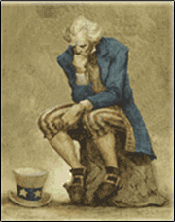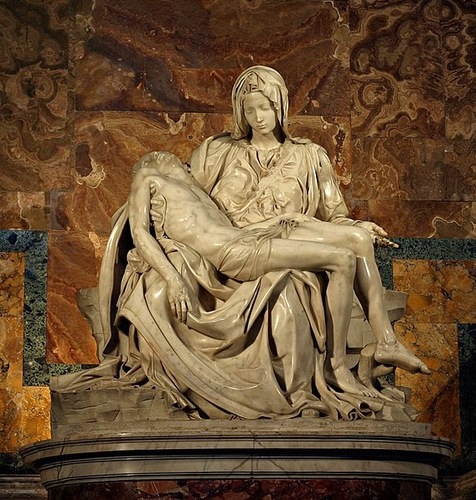
(function(d, s, id) { var js, fjs = d.getElementsByTagName(s)[0]; if (d.getElementById(id)) return; js = d.createElement(s); js.id = id; js.src = “https://connect.facebook.net/en_US/sdk.js#xfbml=1&version=v3.0”; fjs.parentNode.insertBefore(js, fjs); }(document, ‘script’, ‘facebook-jssdk’)); –>
–>
December 14, 2023
For most of Western history, art was used as a way for patrons to showcase achievements, propagandize citizens, or lionize individuals. Maybe the single greatest artist in human history, Michelangelo, created his greatest works for patrons of various sorts. He created David for the Florentine Guild of Wool, the Pieta for the French ambassador to the Holy See, and the Sistine Chapel and St Peter’s Basilica for popes. Art was, in one way or another, an homage to something greater than its creator.
‘); googletag.cmd.push(function () { googletag.display(‘div-gpt-ad-1609268089992-0’); }); document.write(”); googletag.cmd.push(function() { googletag.pubads().addEventListener(‘slotRenderEnded’, function(event) { if (event.slot.getSlotElementId() == “div-hre-Americanthinker—New-3028”) { googletag.display(“div-hre-Americanthinker—New-3028”); } }); }); }
Fast-forward about three centuries, and the art world begun to change. The idea of art as an indulgence of artists, who paint whatever they want, with or without a desire that someone pay for it, is largely a child of the late 19th century. That’s when Impressionism, that distinctly unconventional, nontraditional form of painting, emerged. In a very short time, the art world went from the uber-traditional world of Bouguereau to the anything-but-traditional world of Monet, Renoir, and Van Gogh. Suddenly, art was no longer a vehicle for vanity or the celebration of greatness or storytelling. It was something else.
In 1917, Marcel Duchamp, a French artist, unveiled a urinal on a wooden box and called it “Fountain.” A hundred years later, art had “evolved” so much that a banana taped to a wall with duct tape (an actual banana…not plastic or paper mâché) would sell for $120,000 in 2019.
It is in this universe of art that we find what is supposed to be cutting edge and courageous, in the form of the Pietà by German designer Harald Glööckler. The revisualization of the classic piece features a tattooed Christ and a trans-Mary. And what’s courageous about this piece? It stands up to those vicious, hateful…Christians.
‘); googletag.cmd.push(function () { googletag.display(‘div-gpt-ad-1609270365559-0’); }); document.write(”); googletag.cmd.push(function() { googletag.pubads().addEventListener(‘slotRenderEnded’, function(event) { if (event.slot.getSlotElementId() == “div-hre-Americanthinker—New-3035”) { googletag.display(“div-hre-Americanthinker—New-3035”); } }); }); }
In the cacophony of 2023, while there are other issues that are of far more import than this, this one might be a bit illustrative.

1Image: Michelangelo’s Pieta by Stanislav Traykov. CC BY-SA 3.0.
Having the “courage” to stand up to Christians by defiling Christian traditions and symbols doesn’t actually require any courage because there’s no danger of anything bad actually happening besides some chastising words from a few of the offended. No one is going to issue death threats against you, no one is going to put a bounty on your head, and mobs of people aren’t going to start riots and kill others because of you, as was shown in 1986 with The Holy Virgin Mary by Chris Ofili and 1987 with Piss Christ, by Andres Serrano. Of course, there is another religion where that’s exactly what happens if one were to criticize it or its symbols…but the same “courageous” artists aren’t assailing that religion.
This is a symbol of the bizarro world we find ourselves living in. Other things that are counted as courageous today include a man announcing that he’s a woman, flaunting one’s morbid obesity in public, or wrapping oneself in the flag of victimization for being black or gay or some other category.
None of those things takes courage in 2023 America, where being anything but a patriotic heterosexual Christian white male accords hero worship. It doesn’t take courage to assail someone or something without threat of consequences.
Heterosexual Christian white males built most (but not all) in which we live today. It’s far from perfect, but no time or place in history has been perfect. But it’s not those males’ DNA that somehow makes them better citizens or better people. No, it’s the culture they built.
We’re told that Western culture is bad because a multicultural collective did not craft it. That makes no sense. Virtually every culture in human history has been built by members of a single race. There weren’t a lot of whites helping to craft the Mali Empire in Africa, a lot of blacks at the center of the Chinese Middle Kingdom, a lot of yellow people helping to build the Inca Empire or a lot of brown people helping to build Russia or the Russian Empire. No, most of human history has been dominated by monochromatic empires, nations, and cultures.
‘); googletag.cmd.push(function () { googletag.display(‘div-gpt-ad-1609268078422-0’); }); document.write(”); googletag.cmd.push(function() { googletag.pubads().addEventListener(‘slotRenderEnded’, function(event) { if (event.slot.getSlotElementId() == “div-hre-Americanthinker—New-3027”) { googletag.display(“div-hre-Americanthinker—New-3027”); } }); }); } if (publir_show_ads) { document.write(“
It just happens to be the case that on Earth’s competitive landscape, straight, Christian white males built and cultivated the culture that has generated the greatest increases in freedom, technology, and prosperity in human history. And it’s not even close. But because not everyone has shared equally in the material gains from that culture, it must be destroyed…
Because that culture largely focuses on meritocracy, accountability, individual liberty, and limited government rather than coercion from above, people who have yet to achieve their desired goals can criticize it with impunity, something they cannot do in most other parts of the world and couldn’t have done throughout most of human history virtually everywhere. Yet even without the threat of consequence, they often call themselves courageous.
Western civilization, the driver of said unprecedented levels of freedom, prosperity, and opportunity in all of human history, today finds itself under attack by those who have migrated to it, have invaded it, or whose ancestors were brought to it because they haven’t achieved their desired goals. This is despite the fact that conditions back wherever they or their ancestors left from are likely far worse than they are anywhere in the West.
But no matter. These “protesters” use the freedoms accorded by Western culture to attack that same culture. That’s a problem. No culture can survive if there are no shared values. No culture can survive if citizens don’t have at least a common appreciation for the nations’ fundamental culture and assume it to be a good thing.
Here at home, if those criticizing America were just a few outliers, there would be no problem. A strong nation can withstand critique, even from within, and that’s why we have a First Amendment. The problem in 2023, however, is that fully half of the country has been brainwashed into believing that the bedrock principles upon which America is based are somehow evil, corrupt, or illegitimate. They got that way because one of the two main political parties has pushed that lie for decades and enlisted its fellow fabulists in the media, academia, and the government to reinforce it.
That is simply not sustainable. Like the movement of art from the classical style of Botticelli, Da Vinci, Rembrandt, and Rubens to the self-important renderings of Basquiat, Mark Rothko, Robert Mapplethorpe, and Glööckler, the transition from a nation built on universal God-given fundamental rights to one based on balkanization and subjective grievances based on “equity” and victimization promises to replace something great with something absurd.
What’s more, that absurd subjective culture cannot long stand. Just as we’ve seen with the Democrat party since the beginning of the war in Gaza, at some point, groups joined by victim status can and will splinter as their various victim classes turn against one another based on the current hierarchy of victim status.
As we march towards what will be the most consequential presidential election in American history, we might want to start suggesting to those who seek to destroy what “white heterosexual Christian males” have built that they look around. They’ll not find a better combination of opportunity, freedom, and real equality anywhere on earth or in history, particularly as it relates to protecting minorities. They should, unlike the Gays for Gaza buffoons we see in the streets, consider what happens to them if they actually get what they wish for.
Follow Vince on Twitter at ImperfectUSA or you can visit his new website Gratitude for America.
<!–
–>
<!– if(page_width_onload <= 479) { document.write("
“); googletag.cmd.push(function() { googletag.display(‘div-gpt-ad-1345489840937-4’); }); } –> If you experience technical problems, please write to [email protected]
FOLLOW US ON
<!–
–>
<!– _qoptions={ qacct:”p-9bKF-NgTuSFM6″ }; ![]() –> <!—-> <!– var addthis_share = { email_template: “new_template” } –>
–> <!—-> <!– var addthis_share = { email_template: “new_template” } –>





